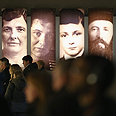
This work is far from being completed. In the past two years, the Holocaust Museum workers – in collaboration with the Yedioth Ahronoth daily – added another layer to the national memory. More than 71,000 personal items – toys, clothes, diaries and souvenirs – have been collected as part of the "Gathering the Fragments" national commemoration campaign, describing the entire lives left behind.
Video courtesy of jn1.tv
As the world marks International Holocaust Day on Sunday, Yad Vashem is opening a special exhibition displaying the backstage of the assembly work of this sad puzzle through some 30 items donated as part of the national rescue campaign.
An iron comb, diaries in German, two tiny phylacteries, a food bowl from the camp and a smiling rag doll can be seen through the exhibition's display windows.
"In the past two years, thousands of people in Israel have decided to bid farewell to personal items which are dear to them, and help commemorate their relatives who were murdered in the Holocaust through them," says Yad Vashem Chairman Avner Shalev.
"Through the examples presented in the exhibition, we tried to emphasize items whose stories are moving and significant and are capable of both explaining a personal story and serving as a testimony."
"Many of the items are delivered to Yad Vashem by members of the second and third generation," says exhibition curator Michael Tal, "so we usually have partial information about the items.
"The exhibition will display the complex research work taking place at Yad Vashem in a bid to complete the information about every single item. We wish to learn as much as we can from the items we receive and offer new insights to the wide audience."
Survivor's teddy bear finds final shelter
One of the exhibition's displays includes a prayer book written by a girl called Hannah Weiss in Soemmerda, a sub-camp of the Buchenwald concentration camp in Germany. Yad Vashem's workers were very excited to receive the prayer book, as they already had a similar one written by Dita Kirshner in the same camp.
The prayer book, which is written in Hebrew but in Hungarian letters, sheds further light on the religious life in the camp.
Another moving item is two metal pins with the names of concentration camps engraved on them. These are tragic souvenirs which were secretly created by prisoners in the camps, who traded in them for portions of food. The pins are engraved with a silent documentation of what their owners went through.
Yaakov Yablonsky passed through six camps, including Buchenwald, before reaching Nickelsdorf, where he was liberated. His pin was donated by his son, Chaim. A shred of the prisoner outfit of Yaakov Berkovich of Krakow was found next to it, with his pin on it. He had gone through eight camps before being transported to Nickelsdorf.
The exhibition also presents items which Yad Vashem officials refer to as "spy work" – objects with very little information. For example, during one of the collection days in Kfar Saba, the Holocaust museum received a work of art given to the deliverer's father while he as escaping at the end of the Holocaust. "Take it to the Land of Israel," he was told by a nameless person, who handed him a copper sheet showing four men pushing a sewage cart. Yad Vashem workers believe it is a documentation from the Łódź Ghetto.
"We register every item and name the survivors tell us about," says Tal. "It's a middle-of-the-road exhibition and we're still collecting. In the past, the survivors didn't understand the collective role their items play. Today it's already clear that this is one of the tools which helps us remember the Holocaust."
Some of the survivors whose personal items are being displayed in the exhibition will arrive for the opening. Some of them still visit their items occasionally, including Stella Knobel, who submitted her beloved teddy bear who was with her throughout the years of the war and is now being presented in the exhibition.
"It's hard to describe how excited I am before and during my visit," Knobel wrote to the museum, "when I could hold him again and tell him what I'm going through and how much I miss him. And yet I am glad that the teddy bear finally found his final and safe shelter – forever."
Join rescue operation
Yad Vashem, in collaboration with Yedioth Ahronoth, are continuing the "Gathering the Fragments" campaign aimed at locating items and documents from the Holocaust period. Thousands of people have already handed over items in their possession.
Search your house for every document, photograph or object from the years before the war, during the Holocaust, from life in the DP camps and the immediate post-war period, and submit them to Yad Vashem for posterity.
For more information please call 1-800-25-77-77 (within Israel) or +972-2-6443888 (outside Israel). Email: [email protected]















